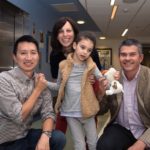It takes a village: Creating best practices for personalized treatments

In 2019, doctors and scientists at Boston Children’s Hospital announced a medical landmark. In the space of one year, a team led by Timothy Yu, MD, PhD, pinpointed a one-of-a-kind genetic mutation in a girl named Mila with Batten disease, developed a custom drug called milasen to repair the mutation, and treated Mila with it. It was the first time an investigational drug had been made for just one person, offering new hope for fatal, ultra-rare diseases that currently have no treatment.
Although Mila passed away in early 2021, the drug curbed her relentless seizures for a time, improved her quality of life, and allowed her to live to age 10. Mila’s story has inspired medical centers around the world to attempt similar fast-track treatments for small groups of patients — or, as in Mila’s case, just one.
“There’s been a explosion of interest,” says Yu, an investigator in the Division of Genetics and Genomics at Boston Children’s. “We’ve been hosting a series of workshops for other investigators interested in developing and testing these customized treatments, and we’ve consistently had more than 50 attendees from more than 40 institutions.”
A growing branch of medicine
Boston Children’s has now launched clinical trials for children with rare mutations that cause a form of progressive neurologic degeneration and a rare form of infant epilepsy. They’re moving cautiously, treating just two patients at a time. Experimental treatments for other rare, life-threatening conditions are in the early stages.
This is not going to be easy. But everybody wants this to work.”
Other hospitals are following suit. Most of these efforts involve antisense oligonucleotide (ASO) drugs, medications that mirror the patient’s mutation and silence its effects. The beauty of ASO drugs is their “plug and play” design. Their chemical backbone stays the same; only the specific genetic code for fixing the mutation is swapped in.
Inspired by the success of nusinersen (Spinraza), an ASO developed for spinal muscular atrophy, a growing number of drug companies are sponsoring clinical trials if there are enough patients (typically a thousand or more) who share the same mutation. But when there’s fewer than that, medical centers must figure out how to develop such trials on their own.
Setting a standard for personalized genetic care
Yu has worked with the U.S. Food and Drug Administration (FDA) for several years to create regulatory standards for emergency use of fast-track custom treatments. Now, funded by the Chan Zuckerberg Initiative, he is leading the N of 1 Collaborative, bringing together like-minded medical centers to compare notes and formulate best practices around individualized treatments. The former director of new drug policy at the FDA is a Collaborative member. In the future, families of children with rare diseases will add their voices to the conversation.
“There are lots of things we’re grappling with,” says Yu. “One is to define under what circumstances it’s even appropriate to try a custom investigational drug. How sick does the child have to be? What is a fair process for assessing eligibility? Is it ethical for a hospital to invest so much time and resources for a handful of patients?”
Fast-track treatments also require honest discussions with families. While the treatments are first tested in cells and animals, no one knows for sure whether they will work in humans, or for how long, until they’re tried. Some may require invasive procedures such as spinal injections or may cause unexpected side effects.
Safely advancing new treatments
Through the N of 1 Collaborative, medical centers can share their experiences, data, methods, and hard-learned lessons. Yu hopes this will help advance the field.
“Institutions often want to keep experimental trials quiet in the early stages,” he says. “But to be responsible, we have to share our experiences to protect each other from mistakes, help each other learn, and make sure we proceed as safely as possible.”
In the future, centers could also collaborate on some parts of drug development — such as toxicology studies — to reduce costs and speed up new treatments. The ultimate goal is to create a blueprint for helping children who have no other options, and often don’t have time on their side.
“This is not going to be easy,” says Yu. “But everybody wants this to work.”
Learn more about the Yu Laboratory and the Division of Genetics and Genomics at Boston Children’s.
Related Posts :
-

Against all odds: Mila's unique mutation, and her own custom drug
Ed. note: Mila passed away in February 2021, at age 10. The Mila’s Miracle Foundation continues to work to pave a ...
-

Shooting for the moon: From diagnosis to custom drug, in one year
Ed. note: Mila passed away in February 2021, at age 10. The Mila’s Miracle Foundation continues to work to pave a ...
-

After decades of evolution, gene therapy arrives
As early as the 1960s, scientists speculated that DNA sequences could be introduced into patients’ cells to cure genetic disorders. ...
-

Made-to-order therapies get a boost with new FDA guidelines
Ed. note: Mila passed away in February, 2021, at age 10. The Mila’s Miracle Foundation continues to work to pave a ...





